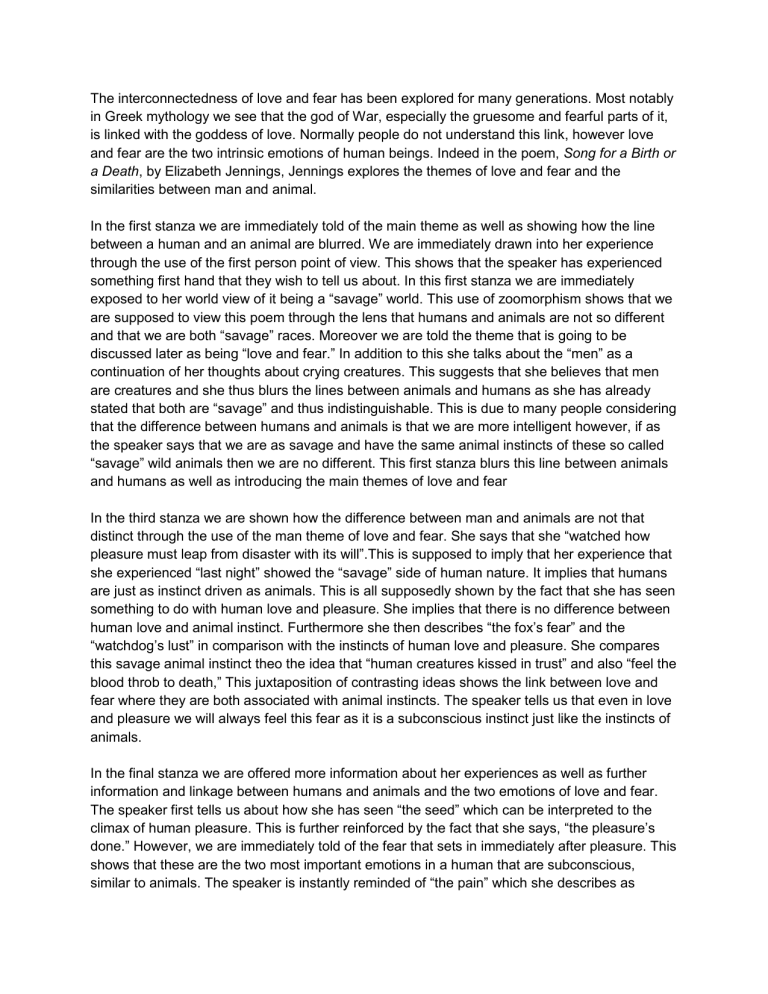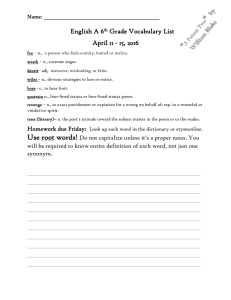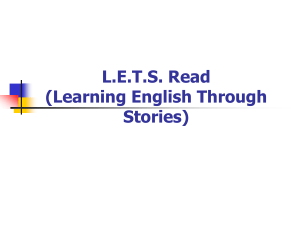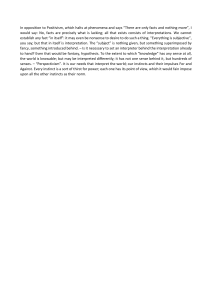
The interconnectedness of love and fear has been explored for many generations. Most notably in Greek mythology we see that the god of War, especially the gruesome and fearful parts of it, is linked with the goddess of love. Normally people do not understand this link, however love and fear are the two intrinsic emotions of human beings. Indeed in the poem, Song for a Birth or a Death, by Elizabeth Jennings, Jennings explores the themes of love and fear and the similarities between man and animal. In the first stanza we are immediately told of the main theme as well as showing how the line between a human and an animal are blurred. We are immediately drawn into her experience through the use of the first person point of view. This shows that the speaker has experienced something first hand that they wish to tell us about. In this first stanza we are immediately exposed to her world view of it being a “savage” world. This use of zoomorphism shows that we are supposed to view this poem through the lens that humans and animals are not so different and that we are both “savage” races. Moreover we are told the theme that is going to be discussed later as being “love and fear.” In addition to this she talks about the “men” as a continuation of her thoughts about crying creatures. This suggests that she believes that men are creatures and she thus blurs the lines between animals and humans as she has already stated that both are “savage” and thus indistinguishable. This is due to many people considering that the difference between humans and animals is that we are more intelligent however, if as the speaker says that we are as savage and have the same animal instincts of these so called “savage” wild animals then we are no different. This first stanza blurs this line between animals and humans as well as introducing the main themes of love and fear In the third stanza we are shown how the difference between man and animals are not that distinct through the use of the man theme of love and fear. She says that she “watched how pleasure must leap from disaster with its will”.This is supposed to imply that her experience that she experienced “last night” showed the “savage” side of human nature. It implies that humans are just as instinct driven as animals. This is all supposedly shown by the fact that she has seen something to do with human love and pleasure. She implies that there is no difference between human love and animal instinct. Furthermore she then describes “the fox’s fear” and the “watchdog’s lust” in comparison with the instincts of human love and pleasure. She compares this savage animal instinct theo the idea that “human creatures kissed in trust” and also “feel the blood throb to death,” This juxtaposition of contrasting ideas shows the link between love and fear where they are both associated with animal instincts. The speaker tells us that even in love and pleasure we will always feel this fear as it is a subconscious instinct just like the instincts of animals. In the final stanza we are offered more information about her experiences as well as further information and linkage between humans and animals and the two emotions of love and fear. The speaker first tells us about how she has seen “the seed” which can be interpreted to the climax of human pleasure. This is further reinforced by the fact that she says, “the pleasure’s done.” However, we are immediately told of the fear that sets in immediately after pleasure. This shows that these are the two most important emotions in a human that are subconscious, similar to animals. The speaker is instantly reminded of “the pain” which she describes as something that “still crouches where the young fox and the child are trapped. This shows that fear is instantly brought about after pleasure linking the two emotions. Moreover she tells us that she also felt the fear of the fox, which shows that animals and humans may not be that different and feel the same subconscious emotions. Finally she then ends the poem with “cires of love are cries of fear” this further links the two emotions together. She traces this back to instinct, claiming that reproduction, in the wild, means the loss of life somewhere. Thus, she attributes her sense of fear of human love to the fact that humans are instinct-driven creatures and that at the core of humanity, instinct is still alive and well. Thus, pleasure and love must always be followed by fear. Love and fear are two inseparable emotions. They always follow each other and are very similar. This is because they are subconsciously the first emotions we get and think about. They are the ones that are also apparent in animals. As Sigmund Freud put it, “a sex drive” is the only thing driving us on. This can be further built on that we are also driven on by the fear of death. In conclusion, in the poem Song for a Birth or for a Death, the poet, Elizabeth Jennings, shows us the interconnectedness between the two emotions of love and fear. Moreover she shows us that animals and humans are not that different where she blurs the lines between them through the entire poem.





